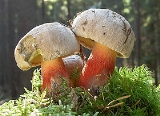
Boletus calopus
Encyclopedia
Boletus calopus, commonly known as the bitter beech bolete or scarlet-stemmed bolete, is a fungus
of the bolete family
, found in Northern Europe and North America. Appearing in coniferous and deciduous woodland in summer and autumn, the fruiting bodies are attractively coloured, with a reddish stem, yellow pores and a beige to olive cap. The bitter-tasting flesh stains blue when broken or bruised and is not edible.
in 1801, it derives its specific name from the Greek
καλος ("pretty") and πους ("foot"), referring to its brightly coloured stalk. Its German name, Schönfußröhrling or 'Pretty-foot bolete' is a literal translation. An alternate common name is scarlet-stemmed bolete.
is beige to olive with yellow pores beneath. The attractively colored stalk
, is yellow above to pink-red below, and with a straw colored network (reticulation). The pale yellow flesh stains blue when broken. The spore print
is olive to olive-brown. The smell can be strong.
woodland, often at higher altitudes, especially under beech
and oak
, on chalky ground from July to December, in Northern Europe and North America's Pacific Northwest
and Michigan
, though the latter appears to be a different subspecies if not a separate species.
Fungus
A fungus is a member of a large group of eukaryotic organisms that includes microorganisms such as yeasts and molds , as well as the more familiar mushrooms. These organisms are classified as a kingdom, Fungi, which is separate from plants, animals, and bacteria...
of the bolete family
Boletaceae
Boletaceae are a family of mushrooms, primarily characterized by developing their spores in small pores on the underside of the mushroom, instead of gills, as are found in agarics. Nearly as widely distributed as agarics, they include the Cep or King Bolete , much sought after by mushroom hunters...
, found in Northern Europe and North America. Appearing in coniferous and deciduous woodland in summer and autumn, the fruiting bodies are attractively coloured, with a reddish stem, yellow pores and a beige to olive cap. The bitter-tasting flesh stains blue when broken or bruised and is not edible.
Taxonomy
Described by Christian Hendrik PersoonChristian Hendrik Persoon
Christiaan Hendrik Persoon was a mycologist who made additions to Linnaeus' mushroom taxonomy.-Early life:...
in 1801, it derives its specific name from the Greek
Ancient Greek
Ancient Greek is the stage of the Greek language in the periods spanning the times c. 9th–6th centuries BC, , c. 5th–4th centuries BC , and the c. 3rd century BC – 6th century AD of ancient Greece and the ancient world; being predated in the 2nd millennium BC by Mycenaean Greek...
καλος ("pretty") and πους ("foot"), referring to its brightly coloured stalk. Its German name, Schönfußröhrling or 'Pretty-foot bolete' is a literal translation. An alternate common name is scarlet-stemmed bolete.
Description
Up to 12 cm (5 in) in diameter, the capPileus (mycology)
The pileus is the technical name for the cap, or cap-like part, of a basidiocarp or ascocarp that supports a spore-bearing surface, the hymenium. The hymenium may consist of lamellae, tubes, or teeth, on the underside of the pileus...
is beige to olive with yellow pores beneath. The attractively colored stalk
Stipe (mycology)
thumb|150px|right|Diagram of a [[basidiomycete]] stipe with an [[annulus |annulus]] and [[volva |volva]]In mycology a stipe refers to the stem or stalk-like feature supporting the cap of a mushroom. Like all tissues of the mushroom other than the hymenium, the stipe is composed of sterile hyphal...
, is yellow above to pink-red below, and with a straw colored network (reticulation). The pale yellow flesh stains blue when broken. The spore print
Spore print
thumb|300px|right|Making a spore print of the mushroom Volvariella volvacea shown in composite: mushroom cap laid on white and dark paper; cap removed after 24 hours showing pinkish-tan spore print...
is olive to olive-brown. The smell can be strong.
Distribution and habitat
It grows in coniferous and deciduousDeciduous
Deciduous means "falling off at maturity" or "tending to fall off", and is typically used in reference to trees or shrubs that lose their leaves seasonally, and to the shedding of other plant structures such as petals after flowering or fruit when ripe...
woodland, often at higher altitudes, especially under beech
Beech
Beech is a genus of ten species of deciduous trees in the family Fagaceae, native to temperate Europe, Asia and North America.-Habit:...
and oak
Oak
An oak is a tree or shrub in the genus Quercus , of which about 600 species exist. "Oak" may also appear in the names of species in related genera, notably Lithocarpus...
, on chalky ground from July to December, in Northern Europe and North America's Pacific Northwest
Pacific Northwest
The Pacific Northwest is a region in northwestern North America, bounded by the Pacific Ocean to the west and, loosely, by the Rocky Mountains on the east. Definitions of the region vary and there is no commonly agreed upon boundary, even among Pacific Northwesterners. A common concept of the...
and Michigan
Michigan
Michigan is a U.S. state located in the Great Lakes Region of the United States of America. The name Michigan is the French form of the Ojibwa word mishigamaa, meaning "large water" or "large lake"....
, though the latter appears to be a different subspecies if not a separate species.

